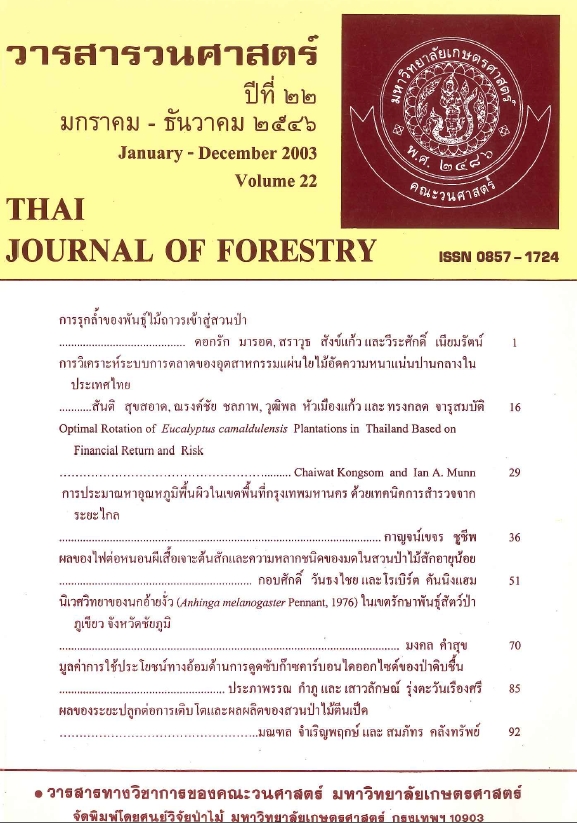การประมาณหาอุณหภูมิพื้นผิวในเขตพื้นที่กรุงเทพมหานครด้วยเทคนิคการสำรวจจากระยะไกล
Main Article Content
บทคัดย่อ
การประมาณหาอุณหภูมิพื้นผิวของกรุงเทพมหานครและบริเวณข้างเคียงดำเนินการโดยการวัดอุณหภูมิพื้นผิวของวัตถุตัวอย่างในภาคสนามแล้วนำมาหาความสัมพันธ์กับค่าหลักเลข (Digital Number, DN) ของข้อมูลภาพถ่ายจากดาวเทียม LANDSAT TM แล้วหาสมการถดถอยเชิงเส้นที่ดีที่สุดโดยให้อุณหภูมิพื้นผิวเป็นตัวแปรตาม และให้ค่า DN ของแบนด์ที่มีความสัมพันธ์มากที่สุดเป็นตัวแปรอิสระ ทำการสุ่มวัดค่า DN จากข้อมูลภาพอย่างเป็นระบบแล้วแทนค่าลงในสมการเพื่อการพยากรณ์หาอุณหภูมิพื้นผิว ณ จุดต่างๆ กระจายทั่วพื้นที่ศึกษานำ ข้อมูลอุณหภูมิพื้นผิวที่ประมาณได้ไปทำการสร้าง SURFACE สำหรับบรรจุค่าอุณหภูมิพื้นผิวของทั้งพื้นที่ศึกษาด้วยวิธีการประมาณค่าในช่วงด้วยเทคนิคที่เหมาะสมผลลัพธ์ที่ได้สามารถใช้สร้างเส้นชั้นอุณหภูมิพื้นผิวเท่าและวิเคราะห์ค่าทางสถิติเพื่อการอธิบายเกี่ยวกับอุณหภูมิและลักษณะของพื้นที่ศึกษาได้ จากการศึกษาพบว่าค่า DN ของข้อมูลภาพถ่ายจากดาวเทียม LANDSAT TM แบนด์ที่ 6 มีความสัมพันธ์อย่างมีนัยสำคัญยิ่งกับข้อมูลอุณหภูมิพื้นผิวของวัตถุในรูปของสมการเอกโพเนนเชียล โดยมีค่าสัมประสิทธิ์ตัวกำหนดเท่ากับ 0.707 สามารถใช้สมการพยากรณ์ค่าอุณหภูมิพื้นผิวเพื่อสร้างเป็น SURFACE ได้ โดยพบว่า SPLINE Interpolator สามารถสร้าง SURFACE ในกรณีศึกษานี้ได้ดี จากการวิเคราะห์ผลพบว่ากรุงเทพมหานครมีอุณหภูมิพื้นผิวของวัตถุปกคลุมดินช่วงเช้าสูงสุดเท่ากับ 60.80 องศาเซลเซียส ที่บริเวณสนามบินดอนเมือง และมีอุณหภูมิพื้นผิวต่ำสุดที่ 25.36 องศาเซลเซียส ซึ่งอยู่บริเวณสวนผลไม้ในเขตตลิ่งชัน นอกจากนี้ยังพบว่าบริเวณตัวเมืองที่มีอาคารสิ่งก่อสร้างหนาแน่นจะมีอุณหภูมิพื้นผิวสูง ส่วนบริเวณชานเมืองจะมีอุณหภูมิพื้นผิวต่ำกว่า โดยในย่านฝั่งธนบุรีที่มีพื้นที่เกษตรกรรมเป็นพวกไม้ผลยืนต้นจะมีอุณหภูมิพื้นผิวต่ำกว่าย่านชานเมืองที่มีพื้นที่เกษตรกรรมเป็นพวกนาข้าวและพื้นที่รกร้าง ดังนั้นการปลูกไม้ยืนต้นในเมืองเป็นผืนกระจายทั่วไปจะสามารถทำให้อากาศเย็นสบายขึ้นได้
Downloads
Article Details

อนุญาตภายใต้เงื่อนไข Creative Commons Attribution-NonCommercial-NoDerivatives 4.0 International License.
ข้าพเจ้าและผู้เขียนร่วม (ถ้ามี) ขอรับรองว่า ต้นฉบับที่เสนอมานี้ยังไม่เคยได้รับการตีพิมพ์และไม่ได้อยู่ในระหว่างกระบวนการพิจารณาตีพิมพ์ลงในวารสารหรือสิ่งตีพิมพ์อื่นใด ข้าพเจ้าและผู้เขียนร่วม (ถ้ามี) ยอมรับหลักเกณฑ์และเงื่อนไขการพิจารณาต้นฉบับ ทั้งยินยอมให้กองบรรณาธิการมีสิทธิ์พิจารณาและตรวจแก้ต้นฉบับได้ตามที่เห็นสมควร พร้อมนี้ขอมอบลิขสิทธิ์ผลงานที่ได้รับการตีพิมพ์ให้แก่วารสารวนศาสตร์ คณะวนศาสตร์ มหาวิทยาลัยเกษตรศาสตร์ กรณีมีการฟ้องร้องเรื่องการละเมิดลิขสิทธิ์เกี่ยวกับภาพ กราฟ ข้อความส่วนใดส่วนหนึ่ง หรือ ข้อคิดเห็นที่ปรากฏในผลงาน ให้เป็นความรับผิดชอบของข้าพเจ้าและผู้เขียนร่วม (ถ้ามี) แต่เพียงฝ่ายเดียว และหากข้าพเจ้าและผู้เขียนร่วม (ถ้ามี) ประสงค์ถอนบทความในระหว่างกระบวนการพิจารณาของทางวารสาร ข้าพเจ้าและผู้เขียนร่วม (ถ้ามี) ยินดีรับผิดชอบค่าใช้จ่ายทั้งหมดที่เกิดขึ้นในกระบวนการพิจารณาบทความนั้น”


